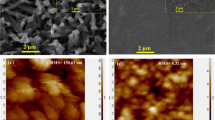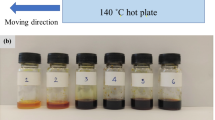Abstract
CH3NH3PbI3 perovskite films were prepared via a hot-casting method using six different CH3NH3I, PbI2 and Pb(SCN)2 solutions. Surface morphology of perovskite films with low SCN− dopant levels (0.0625 M and 0.125 M Pb(SCN)2) showed smooth surfaces and large grain sizes. However, with the high SCN− dopant levels (0.1875 M and 0.25 M Pb(SCN)2), rough surfaces were produced with pinholes. The crystal of pure CH3NH3PbI3 (0 M Pb(SCN)2) film is a tetragonal perovskite structure. XRD spectra of all five Pb(SCN)2 added films show the present of CH3NH3PbI3 films and the additional peak at 12.66°. Rietveld refinement analysis reveals that the Pb(SCN)2 addition causes the second phase PbI2 formation along with the tetragonal MAPbI3 perovskite film rather than the CH3NH3Pb(SCN)xI3-x perovskite formation. The carbon-based hole-transport-layer (HTL)-free perovskite (from 0.0625 M Pb(SCN)2 dopant) solar cell is the optimal ratio in generating a promising cell efficiency, 6.34%, with a good efficiency retention of 79.43% after 30 days of testing in comparison to a pure CH3NH3PbI3 (0 M Pb(SCN)2 dopant) perovskite solar cell with an efficiency retention of only 26.92%. The great stability of the Pb(SCN)2 added perovskite solar cells is attributed to the PbI2 layer covered MAPbI3 grains blocking oxygen and/or water molecules from degrading MAPbI3 perovskite.









Similar content being viewed by others
Data availability
The datasets generated during and/or analyzed during the current study are available from the corresponding author on reasonable request.
References
F. Li, M. Liu, J. Mater. Chem. A 5, 15447 (2017). https://doi.org/10.1039/C7TA01325F
A. Kojima, K. Teshima, Y. Shirai, T. Miyasaka, J. Am. Chem. Soc. 131, 6050 (2009). https://doi.org/10.1021/ja809598r
M.A. Green, E.D. Dunlop, J. Hohl-Ebinger, M. Yoshita, N. Kopidakis, A.W.Y. Ho-Baillie, Prog. Photovoltaics Res. Appl. 28, 3 (2020). https://doi.org/10.1002/pip.3228
NREL, Best Research-Cell Efficiency Chart. (National Renewable Energy Laboratory, 2020), https://www.nrel.gov/pv/cell-efficiency.html. Accessed 22 November 2020
C. Lin, Front. Chem. (2020). https://doi.org/10.3389/fchem.2020.00592
H. Zheng, C. Li, A. Wei, J. Liu, Y. Zhao, Z. Xiao, Int. J. Hydrogen Energy 43, 11403 (2018). https://doi.org/10.1016/j.ijhydene.2018.03.226
I. Mesquita, L. Andrade, A. Mendes, Renew. Sustain. Energy Rev. 82, 2471 (2018). https://doi.org/10.1016/j.rser.2017.09.011
P. Hang, J. Xie, G. Li et al., iScience 21, 217 (2019). https://doi.org/10.1016/j.isci.2019.10.021
N.R. Poespawati, J. Sulistianto, T. Abuzairi, R.W. Purnamaningsih, Int. J. Photoenergy 2020, 8827917 (2020). https://doi.org/10.1155/2020/8827917
L. McGovern, M.H. Futscher, L.A. Muscarella, B. Ehrler, J. Phys. Chem. Lett. 11, 7127 (2020). https://doi.org/10.1021/acs.jpclett.0c01822
P. Kumlangwan, P. Suksangrat, M. Towannang et al., J. Korean Phys. Soc. 77, 1210 (2020). https://doi.org/10.3938/jkps.77.1210
Q. Tai, P. You, H. Sang et al., Nat. Commun. 7, 11105 (2016). https://doi.org/10.1038/ncomms11105
Y. Lou, Y. Niu, D. Yang et al., Nano Res. 11, 2715 (2018). https://doi.org/10.1007/s12274-017-1901-z
Y. Chen, B. Li, W. Huang, D. Gao, Z. Liang, Chem. Commun. 51, 11997 (2015). https://doi.org/10.1039/C5CC03615A
Q. Jiang, D. Rebollar, J. Gong, E.L. Piacentino, C. Zheng, T. Xu, Angew. Chem. Int. Ed. 54, 7617 (2015). https://doi.org/10.1002/anie.201503038
Z. Yao, Z. Jin, X. Zhang et al., J. Mater. Chem. C 7, 13736 (2019). https://doi.org/10.1039/C9TC04851K
Y. Zhang, H. Zhang, X. Zhang et al., Metals 8, 964 (2018). https://doi.org/10.3390/met8110964
T. Liu, Z. Wang, L. Lou, S. Xiao, S. Zheng, S. Yang, Solar RRL 4, 1900278 (2020). https://doi.org/10.1002/solr.201900278
F. Bu, B. He, Y. Ding et al., Sol. Energy Mater. Sol. Cells 205, 110267 (2020). https://doi.org/10.1016/j.solmat.2019.110267
C. Wang, J. Zhang, L. Jiang et al., J. Alloy. Compd. 817, 152768 (2020). https://doi.org/10.1016/j.jallcom.2019.152768
G. Wang, J. Liu, M. Lei, W. Zhang, G. Zhu, Electrochim. Acta 349, 136354 (2020). https://doi.org/10.1016/j.electacta.2020.136354
L. Etgar, P. Gao, Z. Xue et al., J. Am. Chem. Soc. 134, 17396 (2012). https://doi.org/10.1021/ja307789s
H. Zhou, Y. Shi, Q. Dong et al., J. Phys. Chem. Lett. 5, 3241 (2014). https://doi.org/10.1021/jz5017069
K. Cao, Z. Zuo, J. Cui et al., Nano Energy 17, 171 (2015). https://doi.org/10.1016/j.nanoen.2015.08.009
X. Xu, Z. Liu, Z. Zuo et al., Nano Lett. 15, 2402 (2015). https://doi.org/10.1021/nl504701y
W. Ke, C. Xiao, C. Wang et al., Adv. Mater. 28, 5214 (2016). https://doi.org/10.1002/adma.201600594
P. Sukseangrat, N. Faibut, A. Chompoosor et al., J. Mater. Sci.: Mater. Electron. 32, 1 (2021). https://doi.org/10.1007/s10854-020-04924-0
K Persson (2014), Materials Data on PbI2 (SG:156) by Materials Project. https://materialsproject.org/materials/mp-567246/. Accessed 15 May 2021
T. Baikie, Y. Fang, J.M. Kadro et al., J. Mater. Chem. A 1, 5628 (2013). https://doi.org/10.1039/C3TA10518K
T. Oku, Solar cells - New Approaches and Reviews. ed. by L.A. Kosyachenko (Shiga, Japan, 2015), p.78
G. Kresse, J. Furthmüller, Comput. Mater. Sci. 6, 15 (1996). https://doi.org/10.1016/0927-0256(96)00008-0
A. Halder, R. Chulliyil, A.S. Subbiah et al., J. Phys. Chem. Lett. 6, 3483 (2015). https://doi.org/10.1021/acs.jpclett.5b01327
M. Matuchova, K. Zdansky, J. Zavadil, A. Danilewsky, J. Maixner, D. Alexiev, J. Mater. Sci.: Mater. Electron. 20, 289 (2009). https://doi.org/10.1007/s10854-008-9831-x
B. Gebremichael, G. Alemu, G. Tessema Mola (2017) Phys. B. Condens. Matt. 514, 85
Acknowledgements
This work was supported by the Research Network NANOTEC (RNN) program of the National Nanotechnology Center (NANOTEC), NSTDA, Ministry of Higher Education, Science, Research, and Innovation (MHESI) and Khon Kaen University, Thailand, and by National Research Council of Thailand and Srinakharinwirot University (Contract No. 028/2564), and by the Thailand Center of Excellence in Physics (ThEP), and by Research and Graduate Studies, Khon Kaen University, and by the NSRF via the Program Management Unit for Human Resources & Institutional Development, Research and Innovation (Grant No. B05F640110).
Author information
Authors and Affiliations
Contributions
PP—Performing experiment, analyzing data, writing manuscript, revising manuscript. NA—Performing experiment. NC—Performing experiment, analyzing data. PK—Performing experiment. MT—Performing experiment. PK—Writing manuscript. PS—Computer simulation, modifying manuscript. AT—Modifying manuscript. PK—Modifying manuscript. WJ—Modifying manuscript. SP—Suggesting research topic, analyzing data, writing manuscript, revising manuscript. VA—Modifying manuscript.
Corresponding authors
Ethics declarations
Conflict of interest
The authors declare that they have no known competing financial interests or personal relationships that could have appeared to influence the work reported in this paper.
Research Involving Human/Animal Participants
This article does not contain any studies involving animals and humans performed by any of the authors.
Additional information
Publisher's Note
Springer Nature remains neutral with regard to jurisdictional claims in published maps and institutional affiliations.
Supplementary Information
Below is the link to the electronic supplementary material.
Rights and permissions
About this article
Cite this article
Prasan, P., Aunping, N., Chanlek, N. et al. Influence of SCN− moiety on CH3NH3PbI3 perovskite film properties and the performance of carbon-based hole-transport-layer-free perovskite solar cells. J Mater Sci: Mater Electron 33, 1589–1603 (2022). https://doi.org/10.1007/s10854-021-07687-4
Received:
Accepted:
Published:
Issue Date:
DOI: https://doi.org/10.1007/s10854-021-07687-4




